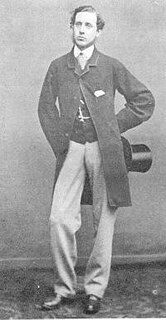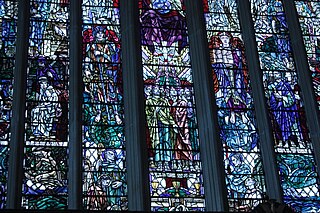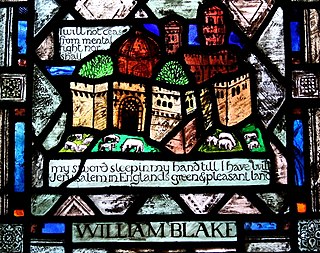
All Saints, Margaret Street, is a Grade I listed Anglo-Catholic church in London. The church was designed by the architect William Butterfield and built between 1850 and 1859. It has been hailed as Butterfield's masterpiece and a pioneering building of the High Victorian Gothic style that would characterize British architecture from around 1850 to 1870.

Hardman & Co., otherwise John Hardman Trading Co., Ltd., founded 1838, began manufacturing stained glass in 1844 and became one of the world's leading manufacturers of stained glass and ecclesiastical fittings. The business closed in 2008.

Charles Eamer Kempe was a Victorian designer and manufacturer of stained glass. His studios produced over 4,000 windows and also designs for altars and altar frontals, furniture and furnishings, lichgates and memorials that helped to define a later nineteenth-century Anglican style. The list of English cathedrals containing examples of his work includes: Chester, Gloucester, Hereford, Lichfield, Wells, Winchester and York. Kempe's networks of patrons and influence stretched from the Royal Family and the Church of England hierarchy to the literary and artistic beau monde.

Douglas Strachan is considered the most significant Scottish designer of stained glass windows in the 20th century. He is best known for his windows at the Peace Palace in The Hague, Netherlands, at Edinburgh's Scottish National War Memorial and in cathedrals and churches throughout the United Kingdom. He is also known for his paintings, murals, and illustrations.

William Wailes (1808–1881) was the proprietor of one of England's largest and most prolific stained glass workshops.

Clayton and Bell was one of the most prolific and proficient English workshops of stained glass during the latter half of the 19th century and early 20th century. The partners were John Richard Clayton (1827–1913) and Alfred Bell (1832–95). The company was founded in 1855 and continued until 1993. Their windows are found throughout the United Kingdom, in the United States, Canada, Australia and New Zealand.

Heaton, Butler and Bayne were an English firm who produced stained-glass windows from 1862 to 1953.

Burlison and Grylls is an English company who produced stained glass windows from 1868 onwards.

Sir (John) Ninian Comper was a Scottish-born architect. He was one of the last of the great Gothic Revival architects, noted for his churches and their furnishings. He is well known for his stained glass, his use of colour and his subtle integration of Classical and Gothic elements which he described as unity by inclusion.

Arthur Louis Moore was an English glass-maker who specialised in stained glass windows.

Mary Lowndes (1857–1929) was a British stained-glass artist who co-founded the stained glass studio and workshop Lowndes and Drury in 1897. She was an influential leader in the Arts and Crafts movement, not only for her stained glass work and successful studio-workshop, but also for opening doors for other women stained glass artists. She was an active participant in the suffragette movement, acting as Chair of the Artists' Suffrage League, and creating poster art to assist the movement.

The Glass House building was a "purpose-built stained-glass studio and workshop" for stained glass artists in Fulham, London. Having gone into partnership in 1897, Mary Lowndes and Alfred Drury had The Glass House built in 1906 for use by independent stained-glass artists.

William Holland was a 19th-century British maker of stained glass and other decorative pieces. His work is represented in churches and stately homes across southern England, Wales, and Ireland. Holland of Warwick windows can be identified by his mark "Guil Holland Vaivic. Puix " written on a scroll in Latin in the lower right hand corner. Holland's stained glass reflects the influence of the Cambridge Camden Society and the Gothic Revival work of Thomas Willement. Willement revived in the early 19th century, the method used at York Minster to build the Great East Window in 1400 wherein coloured pieces are leaded and the lead then becomes part of the design, appearing as black lines in the window.

Caroline Charlotte Townshend (1878–1944) was a British stained glass artist of the Arts and Crafts Movement. She trained at Slade School of Fine Art and Central School of Arts and Crafts before becoming a pupil of Christopher Whall. She designed and made many stained glass windows, particularly for churches and cathedrals and set up the stained glass firm of Townshend and Howson in 1920 with her student and apprentice, Joan Howson. They used a dual signature for their completed works.

St Margaret's Church, is a Category B listed church of the Scottish Episcopal Church at 355 Kilmarnock Road, Newlands, Glasgow, Scotland.

The Church of St Mary is the Anglican parish church for the town of Bideford in Devon in the UK. Built in 1865, it replaces a Norman church of 1260. The church has been Grade II* listed by Historic England since 1949 and comes under the Diocese of Exeter.

The firm of Goddard & Gibbs were London-based English glassmakers and stained glass window manufacturers. The company was established in 1868, although one firm which it subsequently acquired had been established earlier, in 1855. Goddard & Gibbs itself was formed by a merger in 1938; the company continued to trade until it was acquired by Hardman & Co. in 2006. Hardman itself ceased to trade in 2008.

















